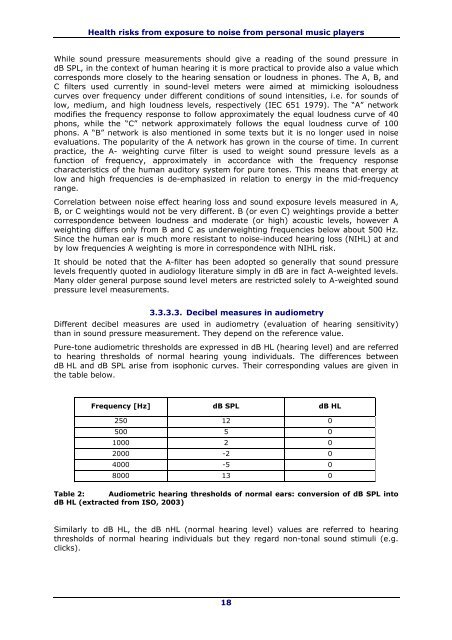Potential health risks of exposure to noise from personal music ...
Potential health risks of exposure to noise from personal music ...
Potential health risks of exposure to noise from personal music ...
Create successful ePaper yourself
Turn your PDF publications into a flip-book with our unique Google optimized e-Paper software.
Health <strong>risks</strong> <strong>from</strong> <strong>exposure</strong> <strong>to</strong> <strong>noise</strong> <strong>from</strong> <strong>personal</strong> <strong>music</strong> playersWhile sound pressure measurements should give a reading <strong>of</strong> the sound pressure indB SPL, in the context <strong>of</strong> human hearing it is more practical <strong>to</strong> provide also a value whichcorresponds more closely <strong>to</strong> the hearing sensation or loudness in phones. The A, B, andC filters used currently in sound-level meters were aimed at mimicking isoloudnesscurves over frequency under different conditions <strong>of</strong> sound intensities, i.e. for sounds <strong>of</strong>low, medium, and high loudness levels, respectively (IEC 651 1979). The “A” networkmodifies the frequency response <strong>to</strong> follow approximately the equal loudness curve <strong>of</strong> 40phons, while the “C” network approximately follows the equal loudness curve <strong>of</strong> 100phons. A “B” network is also mentioned in some texts but it is no longer used in <strong>noise</strong>evaluations. The popularity <strong>of</strong> the A network has grown in the course <strong>of</strong> time. In currentpractice, the A- weighting curve filter is used <strong>to</strong> weight sound pressure levels as afunction <strong>of</strong> frequency, approximately in accordance with the frequency responsecharacteristics <strong>of</strong> the human audi<strong>to</strong>ry system for pure <strong>to</strong>nes. This means that energy atlow and high frequencies is de-emphasized in relation <strong>to</strong> energy in the mid-frequencyrange.Correlation between <strong>noise</strong> effect hearing loss and sound <strong>exposure</strong> levels measured in A,B, or C weightings would not be very different. B (or even C) weightings provide a bettercorrespondence between loudness and moderate (or high) acoustic levels, however Aweighting differs only <strong>from</strong> B and C as underweighting frequencies below about 500 Hz.Since the human ear is much more resistant <strong>to</strong> <strong>noise</strong>-induced hearing loss (NIHL) at andby low frequencies A weighting is more in correspondence with NIHL risk.It should be noted that the A-filter has been adopted so generally that sound pressurelevels frequently quoted in audiology literature simply in dB are in fact A-weighted levels.Many older general purpose sound level meters are restricted solely <strong>to</strong> A-weighted soundpressure level measurements.3.3.3.3. Decibel measures in audiometryDifferent decibel measures are used in audiometry (evaluation <strong>of</strong> hearing sensitivity)than in sound pressure measurement. They depend on the reference value.Pure-<strong>to</strong>ne audiometric thresholds are expressed in dB HL (hearing level) and are referred<strong>to</strong> hearing thresholds <strong>of</strong> normal hearing young individuals. The differences betweendB HL and dB SPL arise <strong>from</strong> isophonic curves. Their corresponding values are given inthe table below.Frequency [Hz] dB SPL dB HL250 12 0500 5 01000 2 02000 -2 04000 -5 08000 13 0Table 2: Audiometric hearing thresholds <strong>of</strong> normal ears: conversion <strong>of</strong> dB SPL in<strong>to</strong>dB HL (extracted <strong>from</strong> ISO, 2003)Similarly <strong>to</strong> dB HL, the dB nHL (normal hearing level) values are referred <strong>to</strong> hearingthresholds <strong>of</strong> normal hearing individuals but they regard non-<strong>to</strong>nal sound stimuli (e.g.clicks).18
















